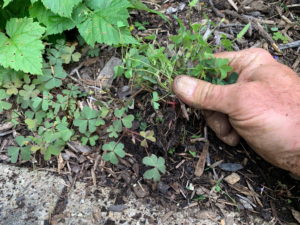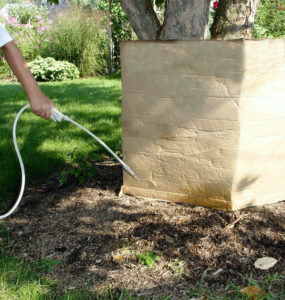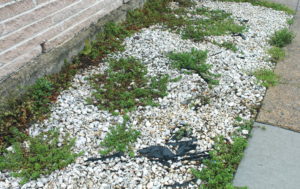Eight Weed Mistakes
July 26th, 2022
One day earlier this month while down on my knees doing battle with the oxalis, it occurred to me that a lot can go wrong in a gardener’s weed-fighting efforts.

Oxalis is one of my many new weed nemeses.
A lot can go wrong anywhere in the garden, for that matter. But narrowing it down to weeds, it’s easy to get overwhelmed or even make things worse by not pulling the right levers.
On the other hand, this is one battle we can win if we do enough things right.
After 34 years of tending my previous Cumberland County third of an acre, weeds were little more than a minor annoyance.
To get there, though, I muddled and botched my way through plenty of lessons. I thought I’d share eight of them with you here… on the off-chance that you’re getting fed up with a never-ending stream of green invaders by now.
1.) The curse of bare ground. Ever hear the saying that “weeds are nature’s way of healing bare soil?” It’s true because bare soil erodes, and the way nature conserves soil is by putting something there to keep it in place.
That “something” is usually the first plant that can seed or creep its way into an opening and then muster enough gumption to fend off competitors. Weeds fit that description.
The solution is to fill all ground with plants that you want, whether it’s grass in a lawn, wall-to-wall shrubs and perennials in a border bed, or groundcovers under a tree.
You might’ve heard the saying that “if you have too many weeds, you don’t have enough plants.” That one’s also true.
If you don’t/can’t be fully planted, the second best thing is to keep the ground covered with enough organic mulch that it keeps a lid on the germination of new weed seeds.
2.) Never let a weed go to seed. It’s easy for weed troubles to spiral out of control if you run low on yanking stamina, hurt your back, get busy on other things, go away for two weeks in June, or any number of other weed-diverting activities.
Weeds are such prolific seeders that if you let them mature enough to produce viable seeds, a single plant can sometimes lead to thousands of new weeds.
If you can’t remove or kill a weed altogether, at least slice off the seed heads so your future problems don’t multiply.
It’s far better to go on regular patrols with a weeder and five-gallon bucket in hand than to try and slash back an ignored infestation that’s become a seedy jungle. Besides, little weeds come out much easier than big ones.
3.) Avoid disturbing the soil. This one’s really overlooked. Whether you’re pulling a weed or doing anything with a tool in your hand, try to disturb the soil as little as possible.

Tilling stirs up buried, dormant weed seeds.
The more you dig and disturb, the more you’ll stir up buried, dormant weed seeds to the surface, where light and moisture will encourage them to spring back to life.
This is why some of the worst weed outbreaks come after tilling a garden or planting/replanting a bed.
There’s no getting around having to improve atrocious soil when you’re creating a new garden up front, but once plants are in, tread lightly. And stop tilling vegetable and flower beds every year.
Read more in my post on To Till or Not to Till?
4.) Be persistent. If you stay on top of weeds consistently and persistently enough, you will win.
Perennial weeds that are continually whacked off before they have a chance to refuel themselves via photosynthesis eventually will run out of energy and give up – even if you don’t just pull them or kill them outright.
Annual weeds are generally goners once you either pull them or cut them off at ground level. And if you do that before any of them produce seed, you’ve stopped their method of spreading.
As for woody weeds, the slash-and-spray method is pretty effective if you’re OK with herbicides. Otherwise, keep whacking as with perennial weeds to run their root systems dry of energy, or use a hefty tool like a mattock or sturdy shovel to dig out whole rootballs. No weed yet has developed resistance yet to manual removal.
When you remove a weed, try to get the entire root system. Some weeds (yeah, you, thistle) are adept at regrowing when even a small piece of root is left behind.
If a woody weed keeps trying to grow back, whack it again, spray it again, or dig the missed root pieces ASAP.
5.) Be careful what you spray. I almost always favor pulling, digging, and whacking over herbicides. I look at it as “harvesting compost” since this short-circuited weed foliage goes into my compost pile to create black gold for my garden.

No weed is resistant yet to being pulled out of the ground, roots and all.
However, this is getting harder with age, and some day I may have to rethink that strategy.
Herbicides come with an environmental cost (not to mention a cash one), but they are effective, and they do make weed control easier. That’s assuming you’re using the right product for the right job.
Keep in mind that there are two main classes of herbicides – “non-selective” ones that kill pretty much anything green and “selective” ones that target certain kinds of plants.
Round-up (i.e. glyphosate) and even “organic” weed-killers containing acetic acid or soap of fatty acids are examples of non-selective herbicides.
Broadleaf weed-killers for lawns are the most common examples of a selective herbicide. These are formulated to kill scores of broadleaf weeds without harming turfgrass.
Many a rookie lawn-owner has mistakenly used Round-up or similar non-selective herbicides on lawn weeds, only to have everything brown out.
Read those labels to make sure the product kills only what you want to kill and that it’s effective against the weeds you have.
6.) Be careful how you spray. Related to the above is the fact that herbicides can do unintended or off-target damage if you don’t use them the right way.
One common issue is when home-owners double or triple the strength, using the logic that if the recommended dose works, double the dose will work twice as well or twice as fast.
Bad logic. Too-strong mixes not only may be more hazardous to you and the environment, they might even harm plants you don’t want to harm (i.e. a broadleaf weed-killer for lawns can stunt or kill grass if it’s not diluted enough).
A second issue is the timing of the spray. If you apply a spray in the middle of a hot, sunny day, the oils in it may heat enough to damage leaf tissue of plants you don’t want to harm.

Barriers like this piece of cardboard can keep herbicide spray from drifting where you don’t want it.
And third, there’s the issue of spray drift. If you’re not careful, spray from your herbicide could drift onto nearby plants and kill them, too. Either direct spray very carefully or place barriers between weeds and your “keeper” plants while spraying.
7.) The limits of weed preventers. Some gardeners turn to granular weed preventers as an aid in weed control.
While Preen (the best known brand) and its cousins are effective in stopping a lot of new weeds from germinating and can be used right over top of most existing garden plants, they’re not a panacea.
For one thing, as the name implies, these are weed preventers, not weed-killers. That means they don’t kill existing weeds. You’ll still have to pull or kill the plantain or creeping charlie you already have.
Second, weed preventers don’t prevent all possible weeds from germinating. The labels spell out the ones they stop. That means if you have seeds of weeds that aren’t subject to the product’s action, they could germinate.
I learned that lesson years ago when I used a product called Snapshot, which prevented most kinds of weeds in a new annual-flower bed but didn’t stop galinsoga. The bottom line is that I still had a gazillion weeds to pull… they were just all galinsoga instead of a dozen different kinds of weeds.
Third, timing is key with weed preventers. You have to get them down and watered before weeds are up and growing, and you have to replenish them two or more times a year since the active ingredients break down in eight to 12 weeks.

Speedwell and a few other weedy creepers are undaunted in this of landscape fabric covered with stone.
8.) The old stone-over-fabric trick. When gardeners first hear about landscape fabric, they often view it as the once-and-final solution to weeds. They’re led to believe that if they lay this durable black cloth-like material over the soil and then cover it with stone or mulch, weeds will become just a bad memory.
What I’ve found (and research bears out) is that the fabric impedes the movement of oxygen and carbon dioxide into and out of the soil and prevents rain from soaking in – even the kind of fabric with tiny openings.
Plants usually stunt when surrounded by fabric, and I’ve seen their roots grow onto the underside of the fabric, as if they’re gasping for a way out of the asphyxiating lid.
If that’s not bad enough, after a few years (even in paths), enough dirt, fallen leaves, and other blowing-around organic matter works its way into the stone that weeds start germinating on top of the fabric.
A mulch covering only makes it worse. As that breaks down in two or three years, the now-composted mulch makes an excellent weed-sprouting medium.
For more on this (and to see a case study in action), check out this post on the Garden Professors blog.
For help identifying weeds, two good online sites with photos are Rutgers Cooperative Extension and Virginia Tech University.
An excellent book with photos and growth habits of most weeds is “Weeds of the Northeast” by Richard H. Uva, Joseph C. Neal and Joseph M. DiTomaso (Comstock Publishing Associates/Cornell University Press, 1997, $31.95 paperback).
And an excellent book on weed control is “Weedless Gardening” by Lee Reich (Workman Publishing, 2001, $10.95 paperback).







